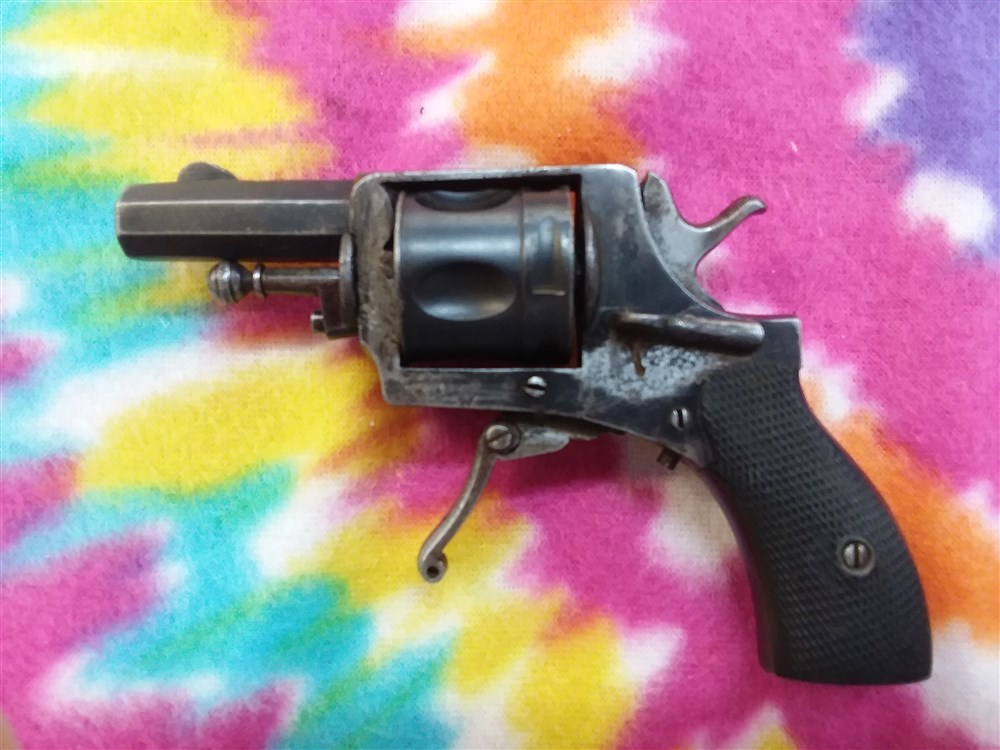|
|

Photo From: TJ Parmele - Album: Handguns--Classic or Antique
Description: Velo Dog revolver Uploaded: 11/3/2018 by TJ Parmele
Camera/Image Info
Camera Make - samsungCamera Model - SM-J727VF-Stop - F/1.9Shutter Speed - 1/17 secFocal Length - 2.91 mmISO-200
See what is being said about this image in the messages area.
Comments on this Image: You must be registered user and logged in to comment.
Login or Register and you will be returned to this image page.
Comments on this Image: You must be registered user and logged in to comment.
Login or Register and you will be returned to this image page.
|
(11/3/2018) TJ Parmele wrote:
The Velo-Dog revolver was introduced in 1894 to allow a bicyclist to protect himself from pursuing dogs. The cartridge, which is a centerfire .22 of slightly less power than a .22 Long Rifle, was responsible for a change in the NRA Pistol Rules. Col. Charles Askins, a leading pistol competitor, had a Colt Woodsman .22 cal. pistol modified to fire this cartridge and used it in NRA Center Fire matches. The NRA promptly changed the applicable rule from "any center fire cartridge" to "any center fire cartridge .32 caliber or larger." The years following the American Civil War saw the rise of host of companies that produced small, inexpensive metallic cartridge handguns. Product lines ran from copies of firearms by established manufacturers including Smith & Wesson, to derringers and pepperbox pistols, small spur-trigger and folding-trigger pocket revolvers and "Velo Dog" pistols. Some companies manufactured arms under a variety of different names. Corporate names still familiar today saw their beginnings during this period, including Harrington & Richardson and Iver Johnson. Other companies, such as Forehand & Wadsworth, Hopkins and Allen, Merwin Hulbert & Co., prospered for a time before eventually closing, but most firms appeared on the scene for a brief period before vanishing into obscurity. Such names as "Bang-up," "Little Giant," "Swamp Angel," and "Tramp's Terror" were some of the many names under which these pistols were marketed by long-forgotten firms. In addition to American-produced examples, European arms also found a niche in the marketplace. Characteristics of these pistols vary widely. Some were single-shot, while others possessed six- or seven-shot capacity, and at least one revolver utilized two cylinders which yielded a total of 14 shots. Most were small caliber single-action arms which utilized either .22 or .32 rimfire cartridges, although double-action revolvers chambered for .38 centerfire ammunition were also produced. Derringers were typically available in .41 or .44 caliber. An assortment of features could be found, including brass- or steel-framed models; various butt profiles; round- or octagonal-barrels; fluted or smooth cylinders; bead, post, or half-disc front sights; top-strap or open-frame; removable side plates; pivoting top- or side-break mechanisms, some with automatic ejection systems, were available in this class of sidearms. Although higher-quality pocket pistols were produced by several different manufacturers, many guns of this type were inexpensive, low-quality, mass-produced arms. From a collector's standpoint, these guns have not generated a great amount of interest, perhaps because they have little historical significance. Some, however, exhibit features often seen on more expensive arms, including ivory or deluxe walnut grips, nickel or gold plating, and elaborate engraving, and are worthy of a place beside fine firearms by Colt, Remington, or Smith & Wesson in the collector's case. |

